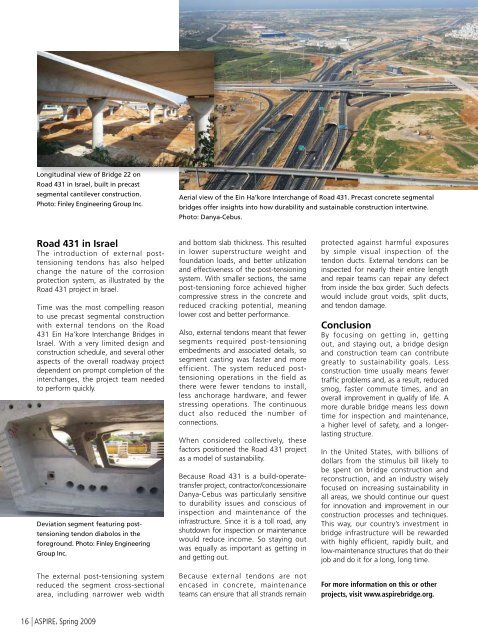ASPIRE Spring 09 - Aspire - The Concrete Bridge Magazine
ASPIRE Spring 09 - Aspire - The Concrete Bridge Magazine
ASPIRE Spring 09 - Aspire - The Concrete Bridge Magazine
Create successful ePaper yourself
Turn your PDF publications into a flip-book with our unique Google optimized e-Paper software.
Longitudinal view of <strong>Bridge</strong> 22 on<br />
Road 431 in Israel, built in precast<br />
segmental cantilever construction.<br />
Photo: Finley Engineering Group Inc.<br />
Aerial view of the Ein Ha’kore Interchange of Road 431. Precast concrete segmental<br />
bridges offer insights into how durability and sustainable construction intertwine.<br />
Photo: Danya-Cebus.<br />
Road 431 in Israel<br />
<strong>The</strong> introduction of external posttensioning<br />
tendons has also helped<br />
change the nature of the corrosion<br />
protection system, as illustrated by the<br />
Road 431 project in Israel.<br />
Time was the most compelling reason<br />
to use precast segmental construction<br />
with external tendons on the Road<br />
431 Ein Ha’kore Interchange <strong>Bridge</strong>s in<br />
Israel. With a very limited design and<br />
construction schedule, and several other<br />
aspects of the overall roadway project<br />
dependent on prompt completion of the<br />
interchanges, the project team needed<br />
to perform quickly.<br />
Deviation segment featuring posttensioning<br />
tendon diabolos in the<br />
foreground. Photo: Finley Engineering<br />
Group Inc.<br />
<strong>The</strong> external post-tensioning system<br />
reduced the segment cross-sectional<br />
area, including narrower web width<br />
and bottom slab thickness. This resulted<br />
in lower superstructure weight and<br />
foundation loads, and better utilization<br />
and effectiveness of the post-tensioning<br />
system. With smaller sections, the same<br />
post-tensioning force achieved higher<br />
compressive stress in the concrete and<br />
reduced cracking potential, meaning<br />
lower cost and better performance.<br />
Also, external tendons meant that fewer<br />
segments required post-tensioning<br />
embedments and associated details, so<br />
segment casting was faster and more<br />
efficient. <strong>The</strong> system reduced posttensioning<br />
operations in the field as<br />
there were fewer tendons to install,<br />
less anchorage hardware, and fewer<br />
stressing operations. <strong>The</strong> continuous<br />
duct also reduced the number of<br />
connections.<br />
When considered collectively, these<br />
factors positioned the Road 431 project<br />
as a model of sustainability.<br />
Because Road 431 is a build-operatetransfer<br />
project, contractor/concessionaire<br />
Danya-Cebus was particularly sensitive<br />
to durability issues and conscious of<br />
inspection and maintenance of the<br />
infrastructure. Since it is a toll road, any<br />
shutdown for inspection or maintenance<br />
would reduce income. So staying out<br />
was equally as important as getting in<br />
and getting out.<br />
Because external tendons are not<br />
encased in concrete, maintenance<br />
teams can ensure that all strands remain<br />
protected against harmful exposures<br />
by simple visual inspection of the<br />
tendon ducts. External tendons can be<br />
inspected for nearly their entire length<br />
and repair teams can repair any defect<br />
from inside the box girder. Such defects<br />
would include grout voids, split ducts,<br />
and tendon damage.<br />
Conclusion<br />
By focusing on getting in, getting<br />
out, and staying out, a bridge design<br />
and construction team can contribute<br />
greatly to sustainability goals. Less<br />
construction time usually means fewer<br />
traffic problems and, as a result, reduced<br />
smog, faster commute times, and an<br />
overall improvement in qualify of life. A<br />
more durable bridge means less down<br />
time for inspection and maintenance,<br />
a higher level of safety, and a longerlasting<br />
structure.<br />
In the United States, with billions of<br />
dollars from the stimulus bill likely to<br />
be spent on bridge construction and<br />
reconstruction, and an industry wisely<br />
focused on increasing sustainability in<br />
all areas, we should continue our quest<br />
for innovation and improvement in our<br />
construction processes and techniques.<br />
This way, our country’s investment in<br />
bridge infrastructure will be rewarded<br />
with highly efficient, rapidly built, and<br />
low-maintenance structures that do their<br />
job and do it for a long, long time.<br />
For more information on this or other<br />
projects, visit www.aspirebridge.org.<br />
16 | <strong>ASPIRE</strong>, <strong>Spring</strong> 20<strong>09</strong>

















